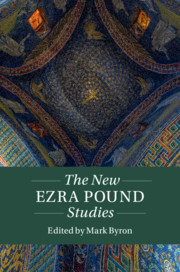Book contents
- The New Ezra Pound Studies
- Twenty-First-Century Critical Revisions
- The New Ezra Pound Studies
- Copyright page
- Contents
- Notes on Contributors
- Key to Abbreviations
- Editor’s Introduction
- Part I Pound’s Texts
- Chapter 1 Classical Literature
- Chapter 2 Early Medieval Philosophy and Textuality
- Chapter 3 Ezra Pound’s Pisan Cantos
- Chapter 4 ‘Scoured and Cleansed’
- Chapter 5 The Visual Field
- Chapter 6 Texts of The Cantos and Theories of Literature
- Chapter 7 Pound and Influence
- Part II Ezra Pound and Asia
- Part III Culture and Politics
- Index
- References
Chapter 5 - The Visual Field
Beyond Vorticism
from Part I - Pound’s Texts
Published online by Cambridge University Press: 17 October 2019
- The New Ezra Pound Studies
- Twenty-First-Century Critical Revisions
- The New Ezra Pound Studies
- Copyright page
- Contents
- Notes on Contributors
- Key to Abbreviations
- Editor’s Introduction
- Part I Pound’s Texts
- Chapter 1 Classical Literature
- Chapter 2 Early Medieval Philosophy and Textuality
- Chapter 3 Ezra Pound’s Pisan Cantos
- Chapter 4 ‘Scoured and Cleansed’
- Chapter 5 The Visual Field
- Chapter 6 Texts of The Cantos and Theories of Literature
- Chapter 7 Pound and Influence
- Part II Ezra Pound and Asia
- Part III Culture and Politics
- Index
- References
Summary
In the introduction to her recent study Reading Cy Twombly, Mary Jacobus sets her interpretation of the artist’s work against those of critics who read the names, titles and quotations in his paintings as, on the one hand, self-expressive (‘sighs, expressions of pleasure or regret’), and on the other, directed towards the creation of a repository of cultural memory. ‘As opposed to a high-humanizing reading of Twombly’s art’, she writes, ‘I want to sidestep the debate in order to recover the specifically twentieth-century avant-garde context for his practice of quotation and allusion – his anthology – by tracing its relation to American literary Modernism, and in particular, Ezra Pound’. Twombly briefly attended Black Mountain College, encountering Pound’s writings and ideas through Charles Olson, and Jacobus turns to Pound’s ABC of Reading (1934) as a particularly clarifying lens through which to read Twombly..
Keywords
- Type
- Chapter
- Information
- The New Ezra Pound Studies , pp. 72 - 87Publisher: Cambridge University PressPrint publication year: 2019



